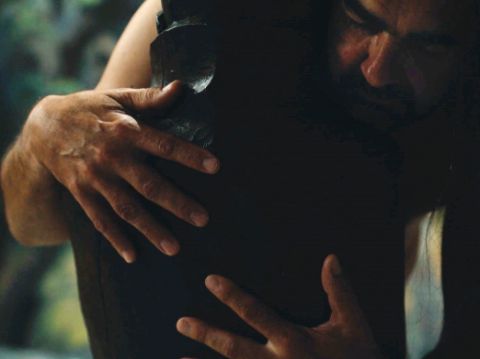Assaf Gruber

Video stills
Never Come Back is a dark archaeological immersion into the conscience and memory of European cultural structures, represented here by an art museum, specifically Graz’s Neue Galerie. A naked accordion player wanders through the museum’s storage area, pulling out mediocre yet evocative paintings depicting European folkloric scenes, as well as landscapes sometimes populated with animals. The paintings sit on an uncomfortable edge between the pastoral and a certain type of imagery abused by National Socialism. The accordion player seems to be seeking inspiration from the paintings, which he eventually finds; the unrecognizable tunes he tentatively plays throughout the first part of the film eventually come together as a rendition of ‘Voyage, Voyage’, the oldie-but-goldie pan-European schlager of a few decades past. Its deeply disturbing lyrics— which one may have missed—are then revealed, overlaid on scenes and close-ups of the paintings. These are made by artists who were indeed Nazi enthusiasts, yet their work is still kept in the vaults of museums. The song’s lyrics convey a cringe exoticism and desire to consume and possess a world as imagined by an imperial European mind. The film’s title is also part of the lyrics, while uncannily alluding to the ghosts of Nazism and colonialism that still haunt Europe. Alongside the video, an uncanny series of photographs, The Conspicuous Parts, depicts coral in seemingly-natural landscapes, which are in fact dioramas preserved in formaldehyde. These are a remnant of another unexpected colonial adventure involving an expedition to Cuba by the German Democratic Republic in the 1960s, during which six tonnes of coral were extracted.
Works in the exhibition: Never Come Back (2022), video installation; The Conspicuous Parts (2018), C-Prints, dimensions vary. Courtesy of the artist